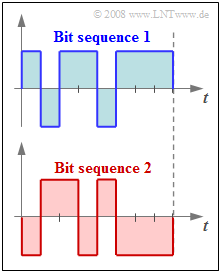Exercise 4.1: PCM System 30/32
From LNTwww
For many years, the PCM system 30/32 was used in Germany, which has the following specifications:
- It allows digital transmission of 30 voice channels in time division multiplex together with one each of synchronization and dial character channels ⇒ the total number of channels is $Z = 32$.
- Each individual voice channel is bandlimited to the frequency range of $300 \ \rm Hz$ to $3400 \ \rm Hz$ .
- Each individual sample is represented by $N = 8$ bits, assuming the so-called dual code.
- The total bit rate is $R_{\rm B} = 2.048 \rm Mbit/s$.
The graph shows the binary representation of two arbitrarily selected samples.
Hints:
- The exercise belongs to the chapter Pulse Code Modulation.
- Reference is made in particular to the page PCM encoding and decoding.
- For the solution of the subtask (2) it is to be assumed: All speech signals are normalized and limited to the range $±1$ amplitude.
Questions
Solution
(1) With $N = 8$ bits a total of $2^8$ quantization intervals can be represented ⇒ $\underline{M = 256}$.
(2) Numbering the quantization intervals from $0$ to $255$, the "bit sequence 1" represents.
- $$ \mu_1 = 2^7 + 2^5 +2^4 +2^2 +2^1 +2^0 = 255 -2^6 -2^3 = 183\hspace{0.05cm},$$
and the "bit sequence 2" for
- $$\mu_2 = 2^6 + 2^5 +2^3 = 104\hspace{0.05cm}.$$
- With the value range $±1$ each quantization interval has width ${\it Δ} = 1/128$.
- The index $μ = 183$ thus represents the interval from $183/128 - 1 = 0.4297$ to $184/128 - 1 = 0.4375$.
- $μ = 104$ denotes the interval from $-0.1875$ to $-0.1797$.
- The sample $-0.182$ is thus represented by the bit sequence 2.
(3) The bit duration $T_{\rm B}$ is the reciprocal of the bit rate $R_{\rm B}$:
- $$T_{\rm B} = \frac{1}{R_{\rm B} }= \frac{1}{2.048 \cdot 10^6\,{\rm 1/s} } \hspace{0.15cm}\underline {= 0.488\,{\rm µ s}} \hspace{0.05cm}.$$
(4) During duration $T_{\rm A}$ binary symbols are transmitted $Z \cdot N$ :
- $$T_{\rm A} = Z \cdot N \cdot {T_{\rm B} } = 32 \cdot 8 \cdot 0.488\,{\rm µ s} \hspace{0.15cm}\underline {= 125\,{\rm µ s}} \hspace{0.05cm}.$$
(5) The reciprocal of $T_{\rm A}$ is called the sampling rate:
- $$f_{\rm A} = \frac{1}{T_{\rm A} } \hspace{0.15cm}\underline {= 8\,{\rm kHz}} \hspace{0.05cm}.$$
(6) The sampling theorem would already be given by $f_{\rm A} ≥ 2 \cdot f_\text{N, max} = 6.8 \ \rm kHz$ Thus the last proposed solution is correct.
